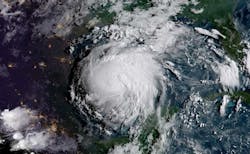Today we conclude our Data Center Executive Roundtable for the first quarter of 2019. In today’s discussion, our panel of experienced data center executives – Chris Sharp of Digital Realty, Tim Mirick of Sabey Data Centers and John Hewitt of Vertiv – examines how best to assess and manage the risk posed by climate change.
The conversation is moderated by Rich Miller, the founder and editor of Data Center Frontier.
Data Center Frontier: The business community is increasingly focused on climate trends and severe weather events, and how they may impact real estate and IT operations. What considerations does climate change present for the data center sector, and what steps should data center companies be considering to address them?
Chris Sharp, CTO, Digital Realty
Chris Sharp: As we’ve experienced in recent years with major storms like Hurricane Sandy and Hurricane Harvey, Mother Nature can be a wild card and come at us with amazing voracity. Severe weather events and climate trends pose a threat to IT infrastructure and the success of businesses. That’s why it’s critical for data center providers to ensure that they have advanced planning in place for when – not if – Mother Nature strikes again.
Business continuity plans can ensure appropriate responses to power outages and identifying various fuel source availability. Additionally, duplicating core operational components – such as UPS, generators, fuel storage, etc. – in a redundant design will help maintain industry-standard uptime levels. If these redundant components fail, it’s important to have a regional disaster recovery plan in place with a “boots on the ground” approach. Equipping local support teams to feel empowered to take action will ensure there is immediate on-site support and ultimately fix any problems sooner. It’s also necessary to have 24x7x365 support through a centralized operations command center that can constantly monitor all data center equipment and activity and be alerted in real-time if there is an issue.
While climate change can certainly have negative effects on data centers, it’s important to recognize that data centers also impact the climate. In the U.S. alone, data centers make up approximately 2 percent of all U.S. electricity use. Data center providers have a responsibility of procuring renewable energy – like the use of solar or wind electricity generators for example – in order to minimize the negative effects on the environment and climate change.
For example, Digital Realty sources approximately 30 percent of its energy from renewable sources globally. The company has signed contracts for utility-scale off-site renewable energy totaling 288 MW. These contracts have the capability to supply the electricity needs of more than 120,000 homes in a typical year and avoid 695,000 metric tons of CO2 emissions annually.
TIM MIRICK, Sabey Data Centers
Tim Mirick: Location is always a critical consideration for any project, and understanding access to natural resources, long-term climate projections and propensity for severe weather events is intrinsic to that process. However, demand drives our customers to need data centers in areas with every natural and man-made threat imaginable, a reality exacerbated as applications and end-user experience drive the need for edge locations in environments more hostile than the industry is used to.
As landlords, we need to build appropriately for each geography we service, evaluating our design on a market by market basis and modifying structural and mechanical systems as appropriate for the level of service we have committed to provide.
Climate trends have also created an even stronger need for a robust disaster recovery or business continuity plan. Whether that strategy leverages the public cloud, colocation, or a hybrid thereof, a site such as Central Washington – with a mild climate and plentiful resources – is critical to a complete data center availability strategy.
JOHN HEWITT, Vertiv
John Hewitt: Severe weather is just one of the many risks data center operators must address to ensure continuity. Those who take emergency preparedness seriously in terms of system configurations, disciplined maintenance and testing practices and well-defined backup plans have shown the ability to remain operational amidst severe weather events. Also, data centers that use infrastructure monitoring and management tools have been found, on average, to have less downtime than data centers that don’t use these tools.
Thinking beyond weather to changes in climate, we can anticipate corresponding changes in resource availability. Water, for example, is an incredibly valuable resource that is becoming more limited in certain parts of the world. The availability and cost of water absolutely should be a consideration for data center companies, and water-free cooling systems are one example of a technology that can address those challenges.
RECAP: Check out the full series of Data Center Frontier’s Executive Roundtable.
Keep pace with the fact-moving world of data centers and cloud computing by following us on Twitter and Facebook, connecting with me on LinkedIn, and signing up for our weekly newspaper using the form below:
About the Author




